This is Part 5 in the series “How to Build a Rainwater Collection System”. Click to see parts one, two, three and four.
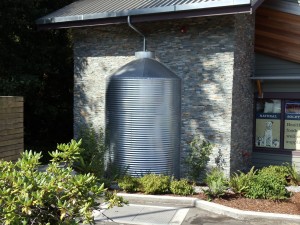 Steel water storage tanks for rainwater collection are generally bolted together grain silos adapted for this use. Made of galvanized corrugated steel panels, wall panels average 17 – 20 gauge with the galvanized roof panels being high rib or flat seam with a center hatch at the top and an access hatch near the bottom of the roof. A felt pre-liner is used between the steel and the main liner to protect it from abrasion. Liners are usually polyethylene and NSF approved when used for potable application or PVC, which is generally used for non-potable. However, PVC can be used for potable, as long as it is NSF approved. RainBank recommends polyethylene for this application.
Steel water storage tanks for rainwater collection are generally bolted together grain silos adapted for this use. Made of galvanized corrugated steel panels, wall panels average 17 – 20 gauge with the galvanized roof panels being high rib or flat seam with a center hatch at the top and an access hatch near the bottom of the roof. A felt pre-liner is used between the steel and the main liner to protect it from abrasion. Liners are usually polyethylene and NSF approved when used for potable application or PVC, which is generally used for non-potable. However, PVC can be used for potable, as long as it is NSF approved. RainBank recommends polyethylene for this application.
Steel tanks need to be built on a engineered cement slab with hold-down anchor brackets designed for the seismic zone where the tank will be placed. Plumbing for overflow, suction, discharge and any cross over lines used in multiple tank applications can either be PVC flanges, polyethylene or PVC boots if coming up through the cement slab. If penetrating through the side of the wall panels, PVC flanges will need to be used.
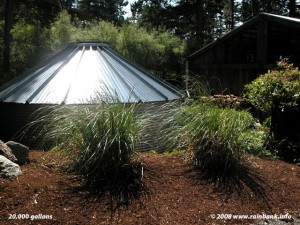 Steel water storage tanks offer durability and protection of the liner from UV rays, plus offers an industrial or rural architectural look. Many commercial applications use this type of storage for both of these reasons. Overflow lines can be installed on the outside of the tank, but it is recommended that any pressurized lines be underground and frost protected in our Washington climate.
Steel water storage tanks offer durability and protection of the liner from UV rays, plus offers an industrial or rural architectural look. Many commercial applications use this type of storage for both of these reasons. Overflow lines can be installed on the outside of the tank, but it is recommended that any pressurized lines be underground and frost protected in our Washington climate.
Accessories include exterior ladders, platforms, and level gauges. The galvanizing does not need painting although if properly prepped, tanks can be painted to suit.
Assembly can be difficult for the homeowner or contractor, so it is recommended that a trained installer with the proper tools and knowledge be used.
Are you interested in building your own water harvesting system? Leave a comment below.

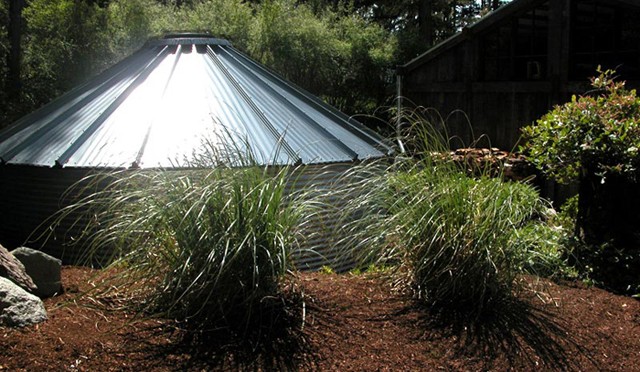
 Storm water is a concern in the Puget Sound area. Storm drains are overwhelmed during a large event resulting in sewage being released in our waterways. Fish, shellfish, and marine animals experience the brunt of these spills. Plus, toxins from roof run-off enter our storm water systems with every rainfall. Roof runoff carries oil from our driveways into the drain system and into the Puget Sound. Pesticides, fertilizers, and pet fecal matter is carried from or roof runoff into the street drainage system and into the storm water resulting in these pollutants entering the ecosystem.
Storm water is a concern in the Puget Sound area. Storm drains are overwhelmed during a large event resulting in sewage being released in our waterways. Fish, shellfish, and marine animals experience the brunt of these spills. Plus, toxins from roof run-off enter our storm water systems with every rainfall. Roof runoff carries oil from our driveways into the drain system and into the Puget Sound. Pesticides, fertilizers, and pet fecal matter is carried from or roof runoff into the street drainage system and into the storm water resulting in these pollutants entering the ecosystem.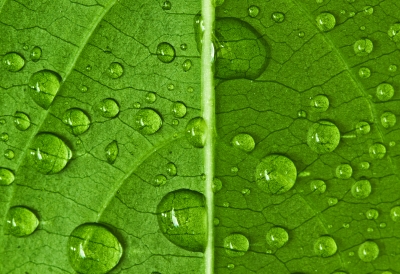
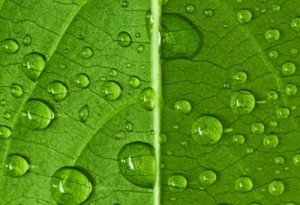 Here in the Seattle area we are fortunate to have enough rainfall to sustain a rainwater collection system year-round. Whether a rainwater catchment system is designed to supplement city water usage, or a larger system designed at the sole source of water for your home, a rainwater collection system will save money on water bills and provide good clean drinking water for your home.
Here in the Seattle area we are fortunate to have enough rainfall to sustain a rainwater collection system year-round. Whether a rainwater catchment system is designed to supplement city water usage, or a larger system designed at the sole source of water for your home, a rainwater collection system will save money on water bills and provide good clean drinking water for your home.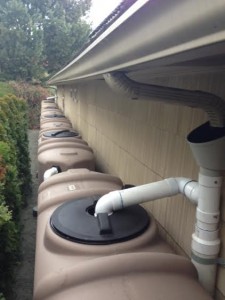 In urban areas, or within Seattle city limits where space is more of an issue, smaller volumes of storage can be used with buried water tanks or slim line design water storage tanks. As little as 3,000 gallons of storage can supplement a house as much as 70 to 80%.
In urban areas, or within Seattle city limits where space is more of an issue, smaller volumes of storage can be used with buried water tanks or slim line design water storage tanks. As little as 3,000 gallons of storage can supplement a house as much as 70 to 80%.